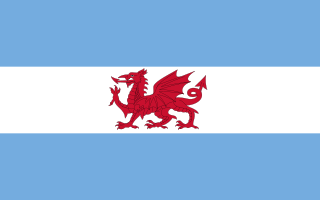
Hedd Wyn was a Welsh-language poet who was killed on the first day of the Battle of Passchendaele during World War I. He was posthumously awarded the bard's chair at the 1917 National Eisteddfod. Evans, who had been awarded several chairs for his poetry, was inspired to take the bardic name Hedd Wyn from the way sunlight penetrated the mist in the Meirionnydd valleys.

Y Wladfa, also occasionally Y Wladychfa Gymreig, refers to the establishment of settlements by Welsh immigrants in the Argentine Patagonia, beginning in 1865, mainly along the coast of the lower Chubut Valley. In 1881, the area became part of the Chubut National Territory of Argentina which, in 1955, became Chubut Province.
Eirug Wyn was a Welsh satirical novelist who wrote in the Welsh language. He was born Eirug Price Wynne, in Llanbrynmair in Mid Wales, and educated at Brynrefail School and Trinity College, Carmarthen. He subsequently made his home in Y Groeslon in North Wales.

Welsh nationalism emphasises and celebrates the distinctiveness of Welsh culture and Wales as a nation or country. Welsh nationalism may also include calls for further autonomy or self-determination, which includes Welsh devolution, meaning increased powers for the Senedd, or full Welsh independence.
This article is about the particular significance of the year 2004 to Wales and its people.
Malcolm Pryce is a British author, mostly known for his noir detective novels.
Mudiad Amddiffyn Cymru, abbreviated as MAC, was a paramilitary Welsh nationalist organisation, which was responsible for a number of bombing incidents between 1963 and 1969. The group's activities primarily targeted infrastructure carrying water to the English city of Liverpool.
Meibion Glyndŵr was a protest group linked to arson of English-owned holiday homes in Wales. They were formed in response to the housing crisis in Wales precipitated by large numbers of houses being bought by wealthy English people for use as holiday homes, pushing up house prices beyond the means of many locals. They were responsible for setting fire to English-owned propierties in Wales from 1979 to the mid-1990s, and only confirm an arrest.
Sir Robert Rees Davies, was a Welsh historian.

Frongoch is a village located in Gwynedd, Wales. It lies close to the market town of Bala, on the A4212 road.
William Edward Julian Cayo-Evans was a Welsh political activist and one time leader of the radical political group Free Wales Army.
This article is about the particular significance of the year 1991 to Wales and its people.
This article is about the particular significance of the year 1977 to Wales and its people.

Mimosa was a clipper ship that gained fame for carrying the first Welsh emigrants to South America in 1865.

Dewi Morgan, also known by his bardic name "Dewi Teifi", was a Welsh bard, scholar and journalist, who won the Chair at the 1925 National Eisteddfod of Wales in Pwllheli with his important awdl recounting the legend of Cantre'r Gwaelod.
Dennis Coslett was a Welsh political activist, best known as a member of the Free Wales Army, who became notorious in 1969.
Gethin ap Gruffydd is a Welsh political and cultural activist, born in Merthyr Tydfil.

Castellau is a hamlet, with a country house of the same name in the county borough of Rhondda Cynon Taf, South Wales. Historically, it lies within the parish of Llantrisant, just north-west of Beddau. It is connected with the history of the Trahernes. In 1988, Ysgol Castellau became the first Welsh medium education school to open in the southeast within new buildings.
Caryl Lewis is a Welsh novelist. She won the Wales Book of the Year in 2005 with her novel Martha Jac a Sianco, which was adapted into a film in 2008.
Rhiannon Ifans, FLSW is a Welsh academic specialising in English, Medieval and Welsh literature. She was an Anthony Dyson Fellow at the Centre for Advanced Welsh and Celtic Studies, in University of Wales Trinity St. David. She twice won a Tir na-n-Og prize for her work and won the literary medal competition at the Welsh Eisteddfod, for her 2019 debut novel, Ingrid, which was chosen for the Welsh Literature Exchange Bookshelf. In 2020, Ifans was elected as a Fellow of the Learned Society of Wales.







